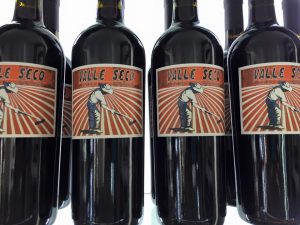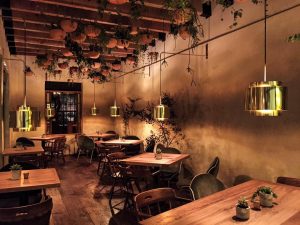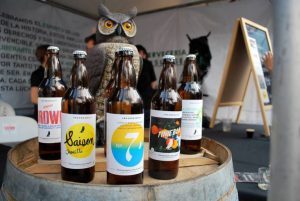Mexico City’s ancient history is as compelling and fascinating as anything you’ll find in the country. Pyramids have always been a cosmic expression of humanity’s search for meaning and an understating of nature and the universe. Theocratic political systems used them as ceremonial temples for the worship the gods and as the centerpieces of their seats of power.
Over hundreds of years, Catholic churches were built on top of them, and even of the same materials providing one more challenge to for anthropologists trying to learn of the origins and evolution of the people who created them. Visiting the pyramids today is still very much a journey of discovery into an extraordinary past, and an experience not to be missed.
Many impressive sites have been restored and can be visited. Still others are hidden away on hilltops – or inside of hills! Others are shrouded in jungle, including within the concrete jungle of Mexico City.
Here are 7 archaeological sites worth a visit the next time you’re in Mexico City.
1) Cerro de la Estrella – Iztapalapa

Cerro de la Estrella is a site in the Iztapalapa borough of Mexico City, at an elevation of some 2,460 meters (8,070ft) above sea level. The summit is thus some 224 m above the Valley of Mexico. Evidence sugests reveals the existence of a housing zone in the middle of the hill, built during the late Classic period (600 to 900 AD). Historical sources establish that the ancient inhabitants of the Mexican Plateau knew the place as Huizachtecatl. The site was very important for the “New Fire” ritual performed there.
The Mexica inherited the Toltec tradition of sun worship as the deity that governed the lives of all beings. They believed that human hearts were required to please the deity in addition to the blood of prisoners of war. For thi reason, every 52 years, at the beginning of two coinciding calendars (Civil and Religious) , the priestly class performed the New Fire ceremony, to prevent the Sun’s death which they thought, would cause total darkness of the universe. A small pyramid can still be appreciated at the archaeological site.
Cerro de la Estrella is one of Mexico City’s oldest archaeological sites. The best way to get there is by metro, line 8, to the Cerro de la Estrella station; or take line 12 to Estación Culhuacán.
2) The Cerro Mazatépetl Pyramid

Mazatépetl is an Eco-archeological Park in San Bernabé Ocotepec, on a large hill called Cerro del Judío or Mazatépetl. The site contains a pyramid at the top of the hill, originally constructed between 1200 and 1380 by the Otomi people. Mazatépetl is one of oldest stone constructions in the Valley of Mexico. The pyramid itself shows, at the foot of the steps, the face of a turtle with the claws of a jaguar. Three crosses at the top of the pyramid were added later by local Catholics. Some of the area’s rural character is preserved in the observances of local religious festivals. The Day of the Cross is celebrated on May 3rd and remains a popular festival in the Magdalena Contreras borough, especially in the La Cruz neighborhood near the Cerro de Judío. During Holy Week, the custom of erecting altars in honor of the Virgin of Sorrows is still observed.
3) The Tequipa Pyramid

In the very south of the city, in the borough of Tlalpan, this site is very near to the famous town of Santo Tomás Ajusco. Though it remains abandoned and deteriorated, the pyramid dates to the Post-Classical period (1325-1521), and according to historical sources was built by the Tepanecas who fled Azcapotzalco in the city’s northwest. They migrated to the Cerro del Judío area but later established themselves in Tequipa. Archaeologist Blanca Paredes claims that Tequipa was a ceremonial center for people living near its periphery. The peak of the structure once had a figure, and pre-Hispanic chest made of basalt and locally known as “El Cuartillo”, which was later taken to the Santo Tomás Ajusco church atrium.
4) The Ehécatl Pyramid

Also known as “La Casa del Viento” (The House of the Wind), this site is located right inside a metro station within the city center. It consists of a small circular altar, which was possibly dedicated to the God of the Wind, known as Ehécatl. The small pyramid is a shrine in honor of the deity who is featured in Aztec and other mythologies of central Mexico. The small pyramid measures 88m2, and was discovered by archaeologists only in 1968. Since the wind blows in all directions, Ehécatl was associated with all the cardinal directions. This temple was built as a cylinder in order to reduce air resistance, and was sometimes portrayed with two protruding masks through which the wind blew.
5) Cuicuilco Pyramid
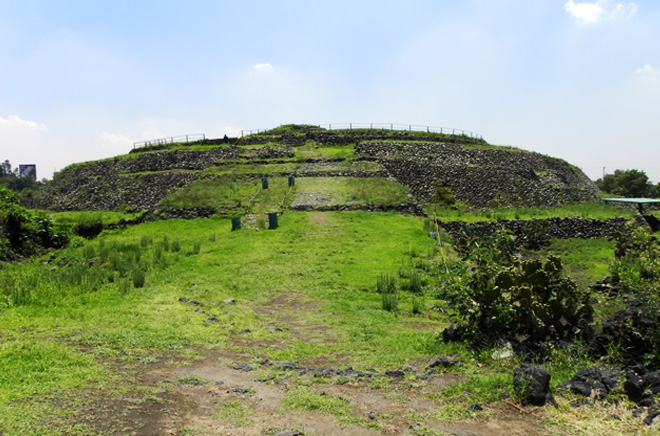
One of the oldest significant remnants of pre-Hispanic settlement within Mexico City, Cuicuilco echoes a civilization that stood on the shores of Lago de Xochimilco as far back as 800 BC. In its heyday in the 2nd century BC, the ‘place of singing and dancing’ counted as many as 40,000 inhabitants. At this time, the Teotihuacán civilization was only beginning it’s rise to dominance. The site was abandoned a couple of centuries later, however, after an eruption of the nearby Xitle volcano covered most of the community in lava.
Based on its date of occupation (c. 700 BCE- 150 CE), Cuicuilco may be the oldest city in the Valley of Mexico. It is the first important civic-religious center of the Mexican Highlands. Originally founded as a farming village, there is evidence of early religious practices including stone offerings and the use of ceramics and grave goods. The city grew around a large ceremonial center with pyramids and an urban area that included plazas and avenues bordering a series of small, shallow pools. Site features include terraces, multiple buildings, fortifications, and irrigation ditches and canals.
Today, Cuicuilco is divided into two zones: Cuicuilco A, where the ceremonial center is located. Cuicuilco B lays to the west in the area of the Olympic Village Sports Centre. Compared to other sites, Cuicilco has barely been studied because the area is almost entirely covered with a lava flow some nine to ten meters thick. This difficulty is compounded by heavy urbanization of the area, with major constructions like the Telmex building and the Cuicuilco Commercial Plaza built directly on top of parts of the site.
6) Mixcoac
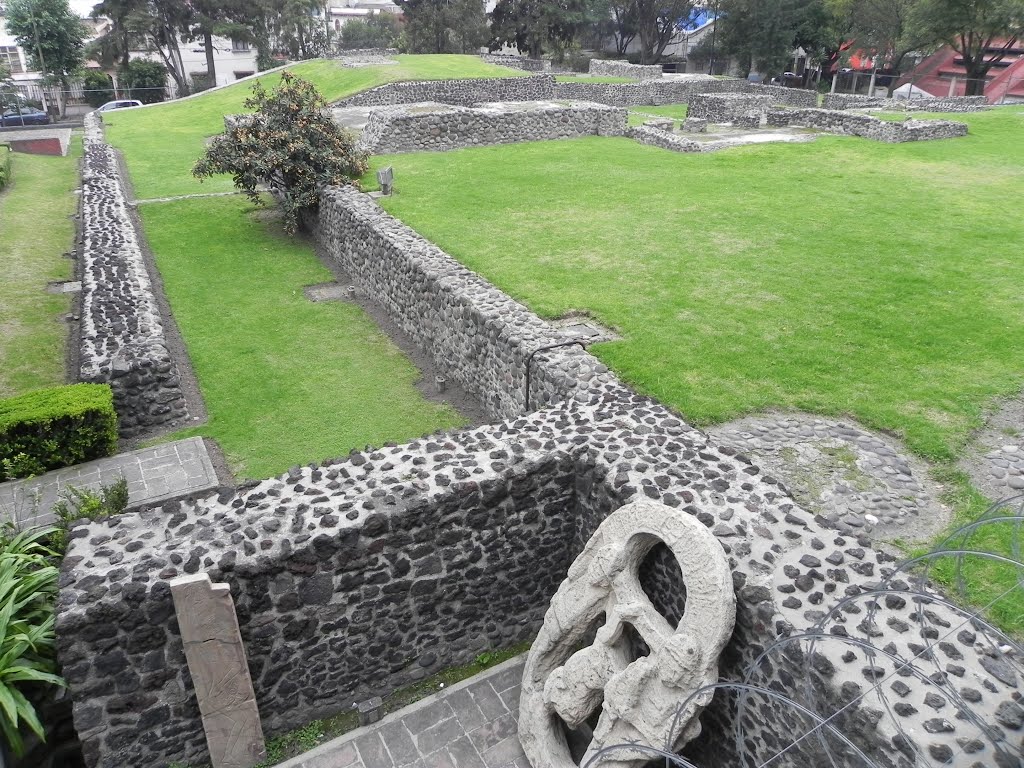
In the colonia, San Pedro de los Pinos, at the corner of avenida San Antonio and Periférico, is a pyramid with stone carvings and slopes, which dates back to about 900 CE. The name “Mixcóac” comes from the Nahuatl language and means “Place of the Serpent Cloud”, alluding to the Milky Way and the god, Mixcóatl. Prior to the Spanish conquest, there was a small settlement on the edge of Lake Texcoco, which was destroyed with the arrival of the Spaniards. In 1521, the Mexicas rebuilt the site and it became a center of festivities with musicians and dancers from Tenochtitlan and Tlatelolco. Cultural activities are staged today in what is called the Centro Cultural La Pirámide.
7) Templo Mayor
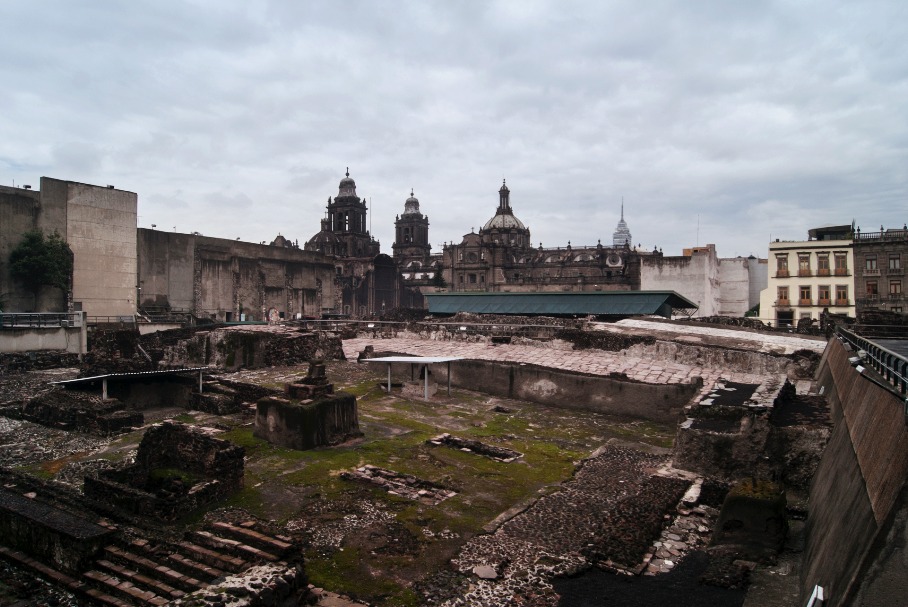
According to legend, the Aztecs were told by the god to found their city where an eagle stood upon a cactus with a snake in its beak. Upon sight of the oracle Tenochtitlan was thus founded and quickly grew to be the epicenter of the powerful Aztec Empire. In 1978, electricity workers unearthed an 8-tonne stone disc, the Coyolxauqui, an Aztec goddess. Further exploration revealed that there was an entire archaeological wonder lying beneath Mexico City’s streets, and a decision was taken to demolish some old colonial buildings, to reveal the Templo Mayor (Main Temple). This was precisely the spot where it is believed the Aztecs saw the sign given to them by their gods and which remains a symbol of Mexico even today. In Aztec belief this was, literally, the center of the universe.
The entrance to the temple site and to museum is east of the National Cathedral, across the Plaza del Templo Mayor. Authorized tour guides (with Sectur ID) offer their services by the entrance. There is an available audio guide in English.
With more visitors than any place else in the region, Mexico City is Latin America’s Favorite for good reason.
Here are just 15 of them!
Mexico City is vibrant, vast and very important. Not just in terms of the space it occupies and the stone and brick from it’s made from, but Mexico City greeted more than 30 million visitors last year. That’s more than it’s entire metro-population (though not by much). Let’s look at why they came.
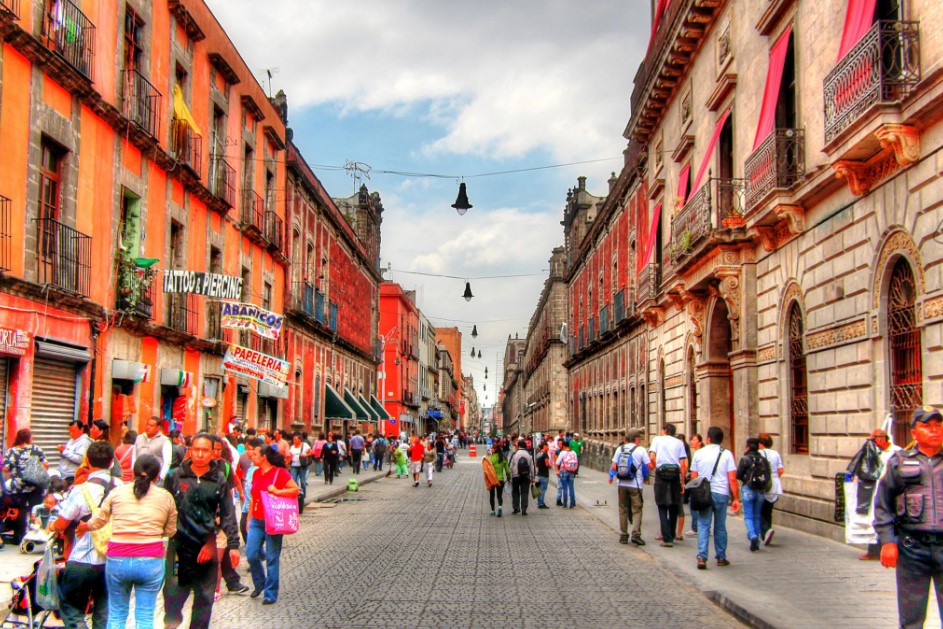
Last year, at about this time, The New York Times had named the city the number one travel destination for 2016. Tourism searches on Google showed Mexico City as not just a Latin American Favorite, but in the top five tourist searches in the world. And of course, people have been asking for the last several years if it wasn’t the Next Paris, or the Next New York or the Next SOMETHING.
The City government set itself to the task of figuring out just why people love coming here. These are the top 15 reasons they came up with, and ultimately they’re the reasons that Mexico City is Latin America’s favorite, and maybe your favorite too!
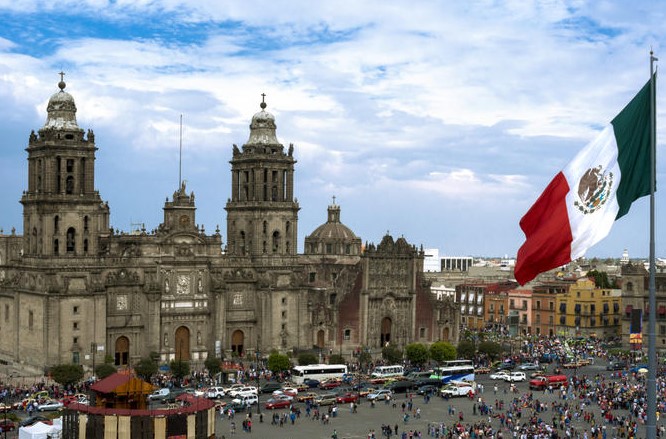
1) 185 museums, nine archaeological sites and four World Heritage sites? The cultural scene is enormous, rich and varied. There’s something for every kind of cultural traveler.
2) Fairs, festivals, conventions, meetings and extravaganzas cover music, food, movies, books, and trade in every kind of human activity, down to the annual clown convention.
3) Blockbuster events? Last year saw a Formula 1 race, an NFL game or two, the Tour de France, and a free Roger Waters concert in the city center.
4) Chosen for the sixth world C40 Mayors Summit in November of 2016, Mexico City is widely perceived as a world leader in combatting climate change.
5) The Metrobús system, originally based on one running in Bogota, Colombia, is now the biggest in Latin America. Stretching some 125 kms today, in 2017 no less than 90 Alexander Dennis Enviro500 double-decker buses will begin plying the length of Paseo de la Reforma, as Metrobus Line 7 officially opens.
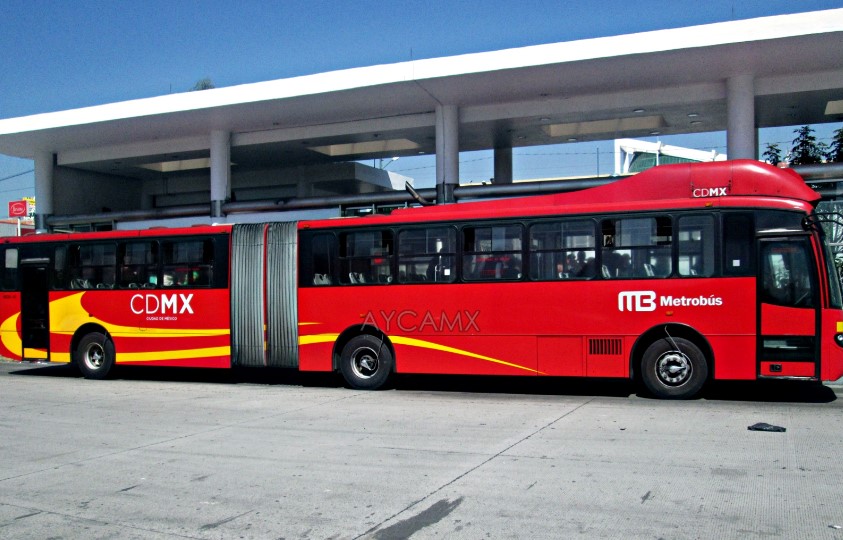
6. The tourist program Sonrisas por tu ciudad, literally “Smiles for your city,” organized by the Secretary for Tourism, has benefited more than 200,000 people.
7. Mexico City’s Central de Abasto (pictured below), after more than 30 years sells 30,000 tons of merchandise (mostly food) and sells to about 30,000 people every day. It’s the largest shopping area in the world.
8. Mexico City was the first Latin American city to join the Rainbow Cities Network, which coordinates city-level actions to protect LGBTI citizens and residents.
9. Mexico City was chosen as the World Capital of Design for 2018, by the World Design Organization.
10. The Centro Histórico is the largest historical city center in Latin America, with 1,500 buildings designated as having historical, cultural, artistic or architectural value. That’s more than most tour guides can handle, but it’s also home the continent’s biggest Metropolitan Cathedral.
 11. Mexico City’s first ever Day of the Dead parade was celebrated by more than 250,000 marchers, band members, onlookers and, yes, zombies.
11. Mexico City’s first ever Day of the Dead parade was celebrated by more than 250,000 marchers, band members, onlookers and, yes, zombies.
12. The city’s El Médico en tu Casa program puts a “Doctor in Your Home.” It’s already recognized in America, Asia, and Europe, for bringing health services closer to people who can’t easily visit hospitals or clinics.
13. Mexico City also began the first Specialized Center for the Management of Diabetes anywhere in Latin America.
14. The Ecobici system (pictured below) is the biggest public bike system in Latin America, with 452 cycle stations and about 35 million trips made by 200,ooo riders every year.
15. And finally, the good old underground Metro network is the biggest in Latin America, too. With 12 lines 226 km in total length, about 5 million people ride it every day.
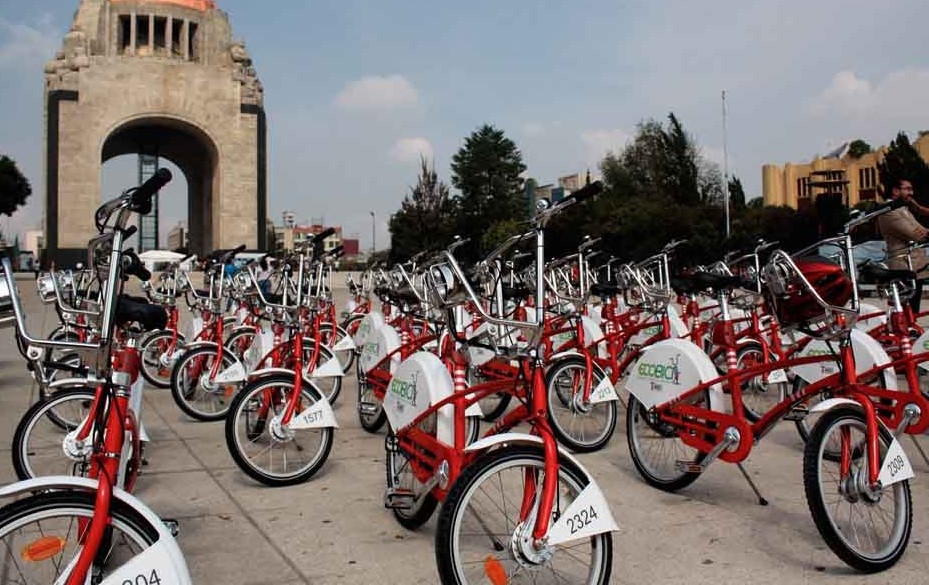
Source: CDMX government, with information from International CDMX and the 4th Governmental Report CDMX, 2016.
Some of Mexico City’s Best Wine Shops are still not backing Mexican Wines. These ones are…
Casa Madero may have been the first winery in the Americas, founded way back in 1597, and way up in Coahuila. But Mexico’s predominant “beer culture” has always given wine producers something of a long shadow to grow up in. Aguascalientes, Querétaro, Guanajuato, Zacatecas and Chihuahua all produce respectable wines, but it’s been the environs of Ensenada (the Guadalupe Valley, the Santo Tomas Valley, and the Ojos Negros Valley) that have really busted the Mexican wine scene out onto international lists of “respectability.” Some parts Coahuila (the Valley Of Parras, and Cuatro Ciénagas in particular) still hold their own – but most wine enthusiasts agree, Baja’s got the wine to beat.
Mexico exports wine around the world. According to the Mexican Wine Council, about 400 brands of wine are currently being produced in the country, and these increasingly appear on the international lists as being wines to watch (and to taste). But those lists aren’t everything. Even the most sophisticated drinkers know today that plenty is coming each year from Mexican wineries that’s worth taking note of.
Yes, you can still find plenty of good Mexican vintages mixed in with the international offerings on the shelves at Liverpool. But the wine shops below are pretty active at pushing good wines, from Mexico, onto more Mexican tables.
Vinoteca
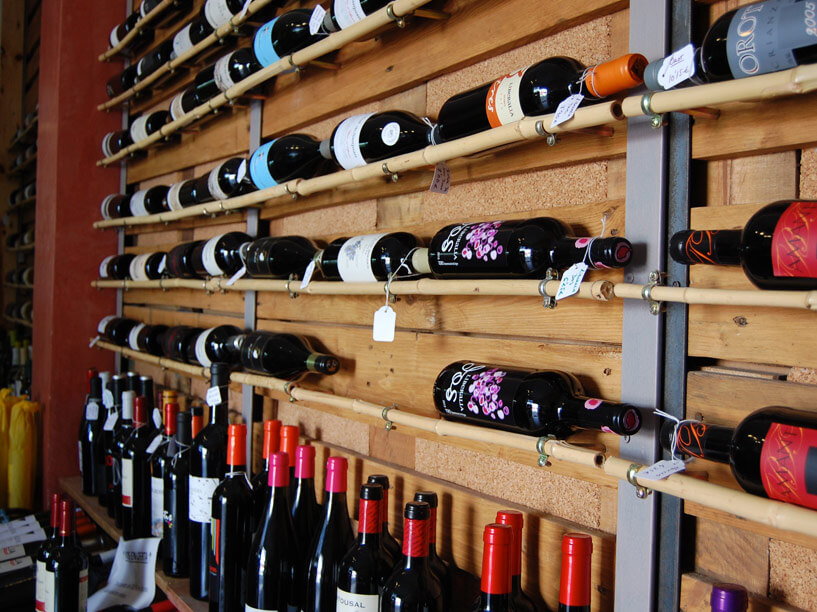
Vinoteca has three locations in and around the city and carries a wide range of Mexican wines, and still more around the country. They do a fair internet trade in wines too, but stopping in lets you pick the brains of their knowledgeable staff.
La Contra
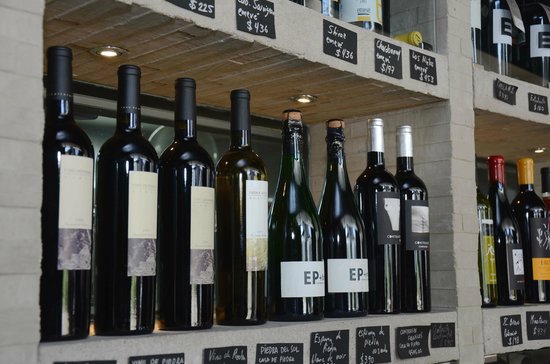
La Contra, also with shops all over the country, is one of the city’s leading advocates for the Mexican wine industry. With a capital location in Roma, it’s an easy and relaxed place to pick up recommendations, or indeed, to sample some of the best bottles coming in.
Address: Álvaro Obregón 130, local # 10, Colonia Roma Norte
Telephone: 5564 0966
Website | Facebook
Á de Acento
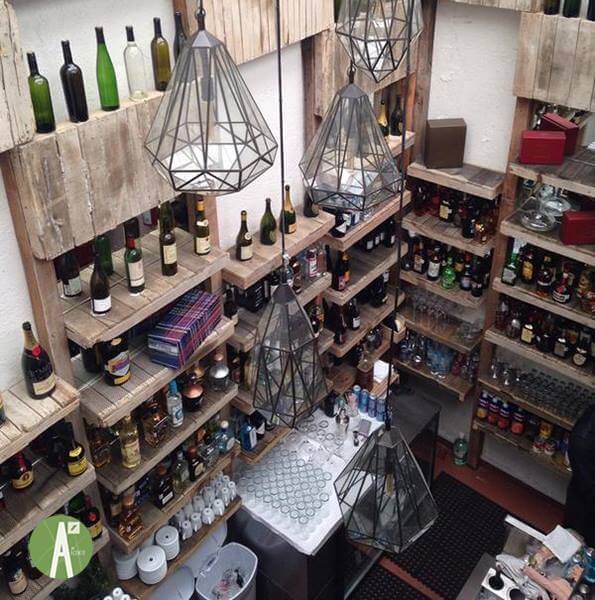
Á de Acento offers a very well-regarded restaurant, but the gourmet shop offers plenty that’s pure Mexican and well worth a bottle or two. In fact, prices are very reasonable, but there’s also usually something special hidden away in the shelves that inquiring customers will be very pleased to find.
Address: Cuernavaca # 85, Colonia Condesa
Telephone: 5260 4721
Website | Facebook
Amaya
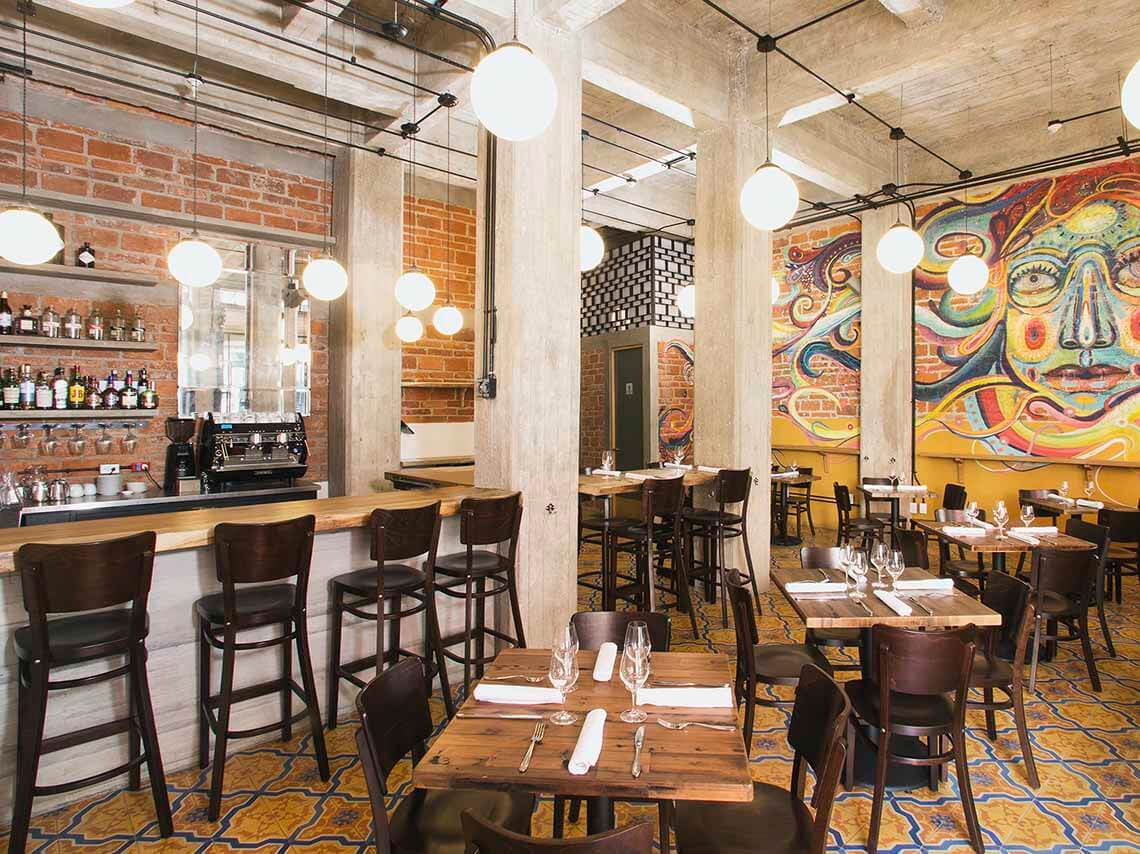
Another in the list of combo restaurant and gourmet shops, Amaya has made a big splash with their list of “vinos raros.” Far from weird, many of them are fabulous. They’re also generally available in the shop, no reservation necessary and many of the best are, in fact, domestically produced!
Address: General Prim # 95, Col. Juárez
Telephone: 5592 5571
Website | Facebook
La Europea
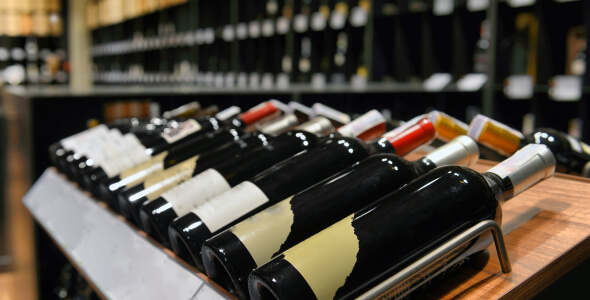
Don’t expect friendly service. La Europea is still trying to figure out in which decade they’re doing business. But for all the wood-boxed bacalao these people sling during the holidays, they’ve always got a ton of good wine, too. With a good number of branches in and around the city, calling them one of the best wine shops in Mexico might be a stretch, but they do a lot of business, and for that, they always offer a ton of good Mexican wines too.
Si Mon

Si Mon is run by the chefs at Broka Bistrot, practically next door. And the emphasis is on local, good, and even inspiring wines. One of the best things about shopping at a wine bar is after all, that there is usually a bottle open. And for that, including Si Mon in a list of the best wine shops is practically a given.
Address: Zacatecas # 126, Colonia Roma Norte
Telephone: 1866 9030
Facebook
Main Photo Above: Aborigen Valle Seco, Petite Sirah, Mourvedre, Cabernet Sauvignon, Courtesy of La Contra


